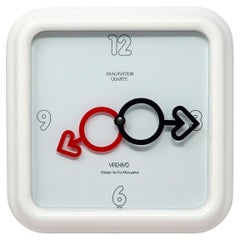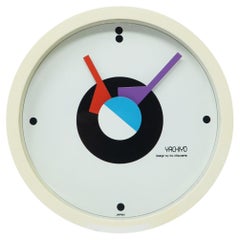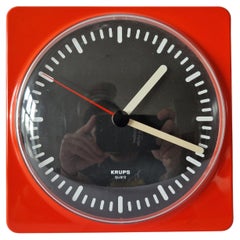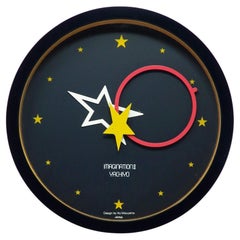Yachiyo Clock
Late 20th Century Japanese Post-Modern Wall Clocks
Plastic
Late 20th Century Post-Modern Wall Clocks
Plastic
Late 20th Century Post-Modern Wall Clocks
Glass, Plastic
Late 20th Century Post-Modern Wall Clocks
Glass, Plastic
People Also Browsed
Vintage 1970s German Mid-Century Modern Wall Clocks
Plastic
Vintage 1970s English Industrial Wall Clocks
Bronze, Steel, Chrome
Late 20th Century Japanese Industrial Wall Clocks
Iron
Vintage 1940s English Industrial Wall Clocks
Bakelite, Glass
Vintage 1970s German Industrial Wall Clocks
Chrome, Iron
20th Century American Post-Modern Table Clocks and Desk Clocks
Brass
Vintage 1960s Swiss Modern Mantel Clocks
Lucite
Antique 19th Century Austrian Victorian Wall Clocks
Oak
20th Century American Mid-Century Modern Wall-mounted Sculptures
Walnut, Textile
Vintage 1970s American Organic Modern Wall Clocks
Copper, Enamel
Vintage 1970s German Industrial Wall Clocks
Plastic, Acrylic
Mid-20th Century French Industrial Wall Clocks
Iron
Antique Late 18th Century Italian Neoclassical Clocks
Metal
Vintage 1970s German Industrial Wall Clocks
Brass
Vintage 1970s Czech Industrial Wall Clocks
Glass, Bakelite
John Gilm...
Late 20th Century American Wall Mirrors
Recent Sales
Late 20th Century Post-Modern Wall Clocks
Glass, Plastic
A Close Look at post-modern Furniture
Postmodern design was a short-lived movement that manifested itself chiefly in Italy and the United States in the early 1980s. The characteristics of vintage postmodern furniture and other postmodern objects and decor for the home included loud-patterned, usually plastic surfaces; strange proportions, vibrant colors and weird angles; and a vague-at-best relationship between form and function.
ORIGINS OF POSTMODERN FURNITURE DESIGN
- Emerges during the 1960s; popularity explodes during the ’80s
- A reaction to prevailing conventions of modernism by mainly American architects
- Architect Robert Venturi critiques modern architecture in his Complexity and Contradiction in Architecture (1966)
- Theorist Charles Jencks, who championed architecture filled with allusions and cultural references, writes The Language of Post-Modern Architecture (1977)
- Italian design collective the Memphis Group, also known as Memphis Milano, meets for the first time (1980)
- Memphis collective debuts more than 50 objects and furnishings at Salone del Milano (1981)
- Interest in style declines, minimalism gains steam
CHARACTERISTICS OF POSTMODERN FURNITURE DESIGN
- Dizzying graphic patterns and an emphasis on loud, off-the-wall colors
- Use of plastic and laminates, glass, metal and marble; lacquered and painted wood
- Unconventional proportions and abundant ornamentation
- Playful nods to Art Deco and Pop art
POSTMODERN FURNITURE DESIGNERS TO KNOW
- Ettore Sottsass
- Robert Venturi
- Alessandro Mendini
- Michele de Lucchi
- Michael Graves
- Nathalie du Pasquier
VINTAGE POSTMODERN FURNITURE ON 1STDIBS
Critics derided postmodern design as a grandstanding bid for attention and nothing of consequence. Decades later, the fact that postmodernism still has the power to provoke thoughts, along with other reactions, proves they were not entirely correct.
Postmodern design began as an architectural critique. Starting in the 1960s, a small cadre of mainly American architects began to argue that modernism, once high-minded and even noble in its goals, had become stale, stagnant and blandly corporate. Later, in Milan, a cohort of creators led by Ettore Sottsass and Alessandro Mendini — a onetime mentor to Sottsass and a key figure in the Italian Radical movement — brought the discussion to bear on design.
Sottsass, an industrial designer, philosopher and provocateur, gathered a core group of young designers into a collective in 1980 they called Memphis. Members of the Memphis Group, which would come to include Martine Bedin, Michael Graves, Marco Zanini, Shiro Kuramata, Michele de Lucchi and Matteo Thun, saw design as a means of communication, and they wanted it to shout. That it did: The first Memphis collection appeared in 1981 in Milan and broke all the modernist taboos, embracing irony, kitsch, wild ornamentation and bad taste.
Memphis works remain icons of postmodernism: the Sottsass Casablanca bookcase, with its leopard-print plastic veneer; de Lucchi’s First chair, which has been described as having the look of an electronics component; Martine Bedin’s Super lamp: a pull-toy puppy on a power-cord leash. Even though it preceded the Memphis Group’s formal launch, Sottsass’s iconic Ultrafragola mirror — in its conspicuously curved plastic shell with radical pops of pink neon — proves striking in any space and embodies many of the collective’s postmodern ideals.
After the initial Memphis show caused an uproar, the postmodern movement within furniture and interior design quickly took off in America. (Memphis fell out of fashion when the Reagan era gave way to cool 1990’s minimalism.) The architect Robert Venturi had by then already begun a series of plywood chairs for Knoll Inc., with beefy, exaggerated silhouettes of traditional styles such as Queen Anne and Chippendale. In 1982, the new firm Swid Powell enlisted a group of top American architects, including Frank Gehry, Richard Meier, Stanley Tigerman and Venturi to create postmodern tableware in silver, ceramic and glass.
On 1stDibs, the vintage postmodern furniture collection includes chairs, coffee tables, sofas, decorative objects, table lamps and more.
Materials: plastic Furniture
Arguably the world’s most ubiquitous man-made material, plastic has impacted nearly every industry. In contemporary spaces, new and vintage plastic furniture is quite popular and its use pairs well with a range of design styles.
From the Italian lighting artisans at Fontana Arte to venturesome Scandinavian modernists such as Verner Panton, who created groundbreaking interiors as much as he did seating — see his revolutionary Panton chair — to contemporary multidisciplinary artists like Faye Toogood, furniture designers have been pushing the boundaries of plastic forever.
When The Graduate's Mr. McGuire proclaimed, “There’s a great future in plastics,” it was more than a laugh line. The iconic quote is an allusion both to society’s reliance on and its love affair with plastic. Before the material became an integral part of our lives — used in everything from clothing to storage to beauty and beyond — people relied on earthly elements for manufacturing, a process as time-consuming as it was costly.
Soon after American inventor John Wesley Hyatt created celluloid, which could mimic luxury products like tortoiseshell and ivory, production hit fever pitch, and the floodgates opened for others to explore plastic’s full potential. The material altered the history of design — mid-century modern legends Charles and Ray Eames, Joe Colombo and Eero Saarinen regularly experimented with plastics in the development of tables and chairs, and today plastic furnishings and decorative objects are seen as often indoors as they are outside.
Find vintage plastic lounge chairs, outdoor furniture, lighting and more on 1stDibs.
Finding the Right wall-clocks for You
Antique, new and vintage wall clocks have become available over the years in a diverse range of materials, such as wood, metal and glass, as well as styles from mid-century modern to Industrial.
Wall clocks have been designed by acclaimed creators and manufacturers such as Howard Miller Clock Company, Junghans Uhren GmbH, Pragotron and more. The Ball clock and Sunflower clock, which were created by designer Irving Harper in George Nelson’s studio during the mid-century era, are known to design enthusiasts and have become highly collectible over the years.
Whether you want an antique timepiece or one that will match a modern motif, you are sure to find one to suit any home or office decor.
The wall clocks of today have come a long way from the mechanical timepieces that originated in the 14th century. One of the most famous clocks from this era was made by Italian astronomer and physician Giovanni de’ Dondi and took approximately 16 years to complete. By the 17th century, wall clocks were popular luxury objects for the home.
Wall clock choices are not limited to just something that keeps time. A 19th-century bronze cartel clock and barometer set is an elegant addition to a foyer, while a vintage world-map clock allows you to see the time in several locations at once. Cleverly designed clocks have been created for all manner of tastes over the years.
On 1stDibs, you will find wall clocks and other types of antique and vintage clocks from various time periods, from Louis XV to Art Deco, and from all over the world, including Germany, France, the United Kingdom and elsewhere. Bring a touch of class and personality into your living room or dining room with a unique timepiece.






